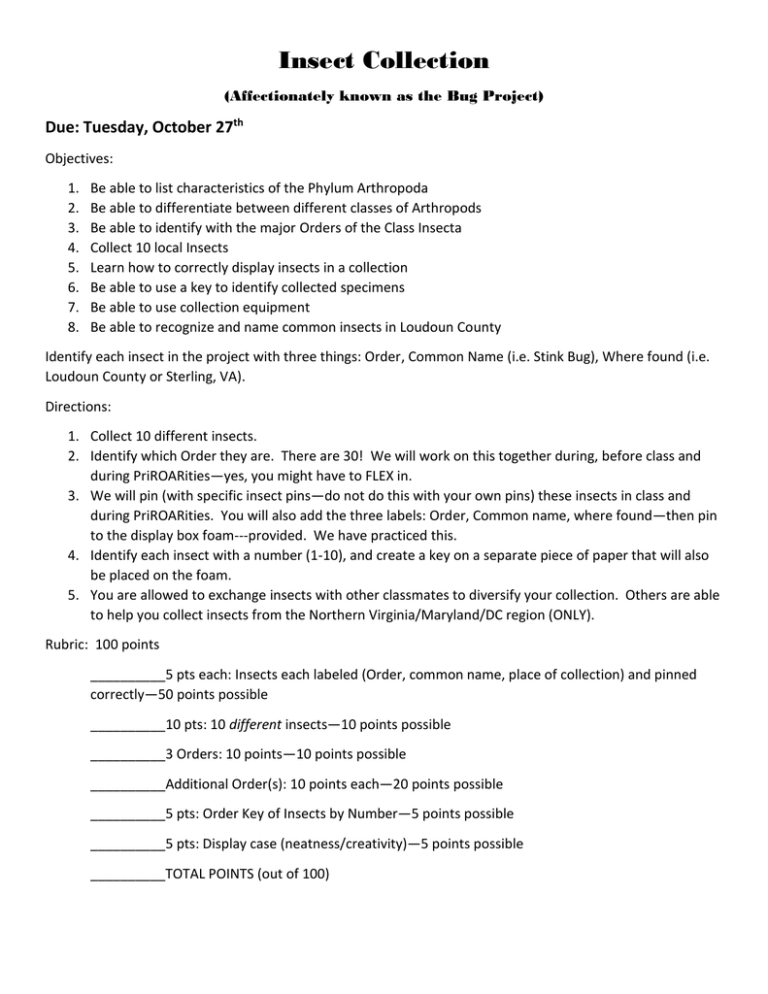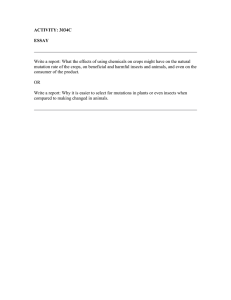Insect Collection Due: Tuesday, October 27
advertisement

Insect Collection (Affectionately known as the Bug Project) Due: Tuesday, October 27th Objectives: 1. 2. 3. 4. 5. 6. 7. 8. Be able to list characteristics of the Phylum Arthropoda Be able to differentiate between different classes of Arthropods Be able to identify with the major Orders of the Class Insecta Collect 10 local Insects Learn how to correctly display insects in a collection Be able to use a key to identify collected specimens Be able to use collection equipment Be able to recognize and name common insects in Loudoun County Identify each insect in the project with three things: Order, Common Name (i.e. Stink Bug), Where found (i.e. Loudoun County or Sterling, VA). Directions: 1. Collect 10 different insects. 2. Identify which Order they are. There are 30! We will work on this together during, before class and during PriROARities—yes, you might have to FLEX in. 3. We will pin (with specific insect pins—do not do this with your own pins) these insects in class and during PriROARities. You will also add the three labels: Order, Common name, where found—then pin to the display box foam---provided. We have practiced this. 4. Identify each insect with a number (1-10), and create a key on a separate piece of paper that will also be placed on the foam. 5. You are allowed to exchange insects with other classmates to diversify your collection. Others are able to help you collect insects from the Northern Virginia/Maryland/DC region (ONLY). Rubric: 100 points __________5 pts each: Insects each labeled (Order, common name, place of collection) and pinned correctly—50 points possible __________10 pts: 10 different insects—10 points possible __________3 Orders: 10 points—10 points possible __________Additional Order(s): 10 points each—20 points possible __________5 pts: Order Key of Insects by Number—5 points possible __________5 pts: Display case (neatness/creativity)—5 points possible __________TOTAL POINTS (out of 100) Steps to Complete the Display How do I know what I’ve got? 1. Start by sorting: Separate everything that has obvious winds from those that don’t. Then sort again into things you recognize, like wasps, flies, beetles, ants, etc. Then sort your specimens according to shape, color, number of legs, and any other differences you can discover and see how many groupings you come up with an how far you can go. For instance, sort everything that looks like a beetle, then separate them into long narrow beetles and those that are round. Then look closer at the types of antenna, shape of wing covers, and any other characteristic that might distinguish one type of beetle from another. This same procedure can be used for all groups of insects. 2. When your insects are sorted, ready to label and you have your 10, ask Mrs. Tracy for your pins. 3. Pin them, use separate foam—like we practiced. What do I do after I pin them? 4. Label them: For each specimen, fill out all three types of labels. Note, this rubric is in a document format and uploaded to my website, if you prefer to use a computer to label your collection. I will work on getting computer access; however, you might have to do this on your time: 1) Order 2) common name 3) place of collection 5. Cut labels out, using a piece of foam, add labels to pinned insects (starting with Order, common name and place of collection on the bottom) Space the labels evenly so your collection is neat. 6. Complete Key with Order of numbered insects Order: Order: Order: Order: Order: Order: Order: Order: Order: Order: Common Name: Common Name: Common Name: Common Name: Common Name: Common Name: Common Name: Common Name: Common Name: Common Name: Found: Found: Found: Found: Found: Found: Found: Found: Found: Found: Key: 1) 2) 3) 4) 5) 6) 7) 8) 9) 10)


